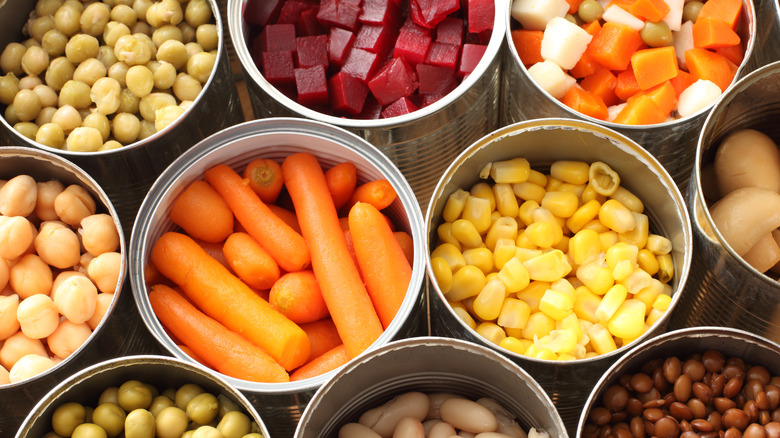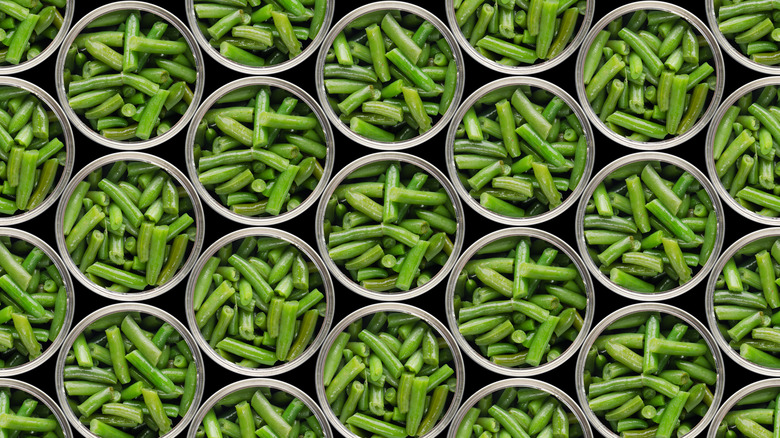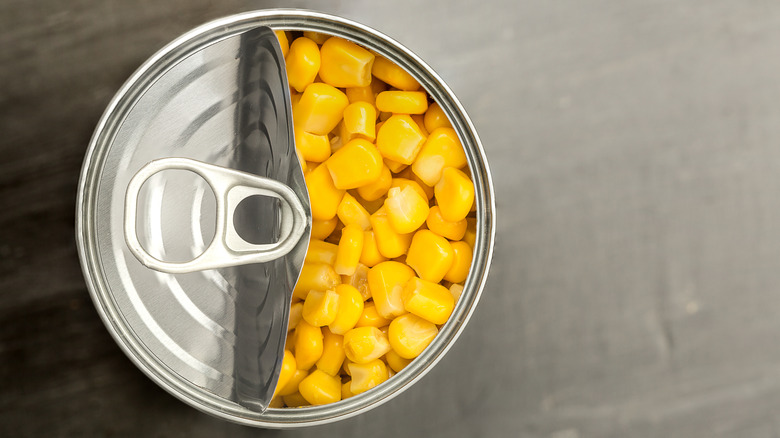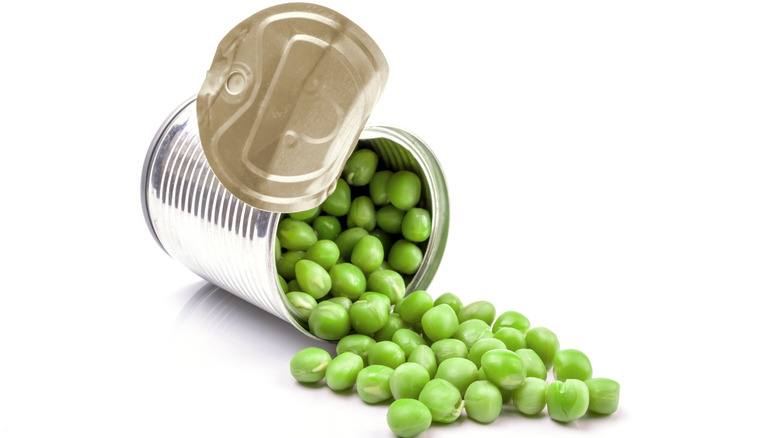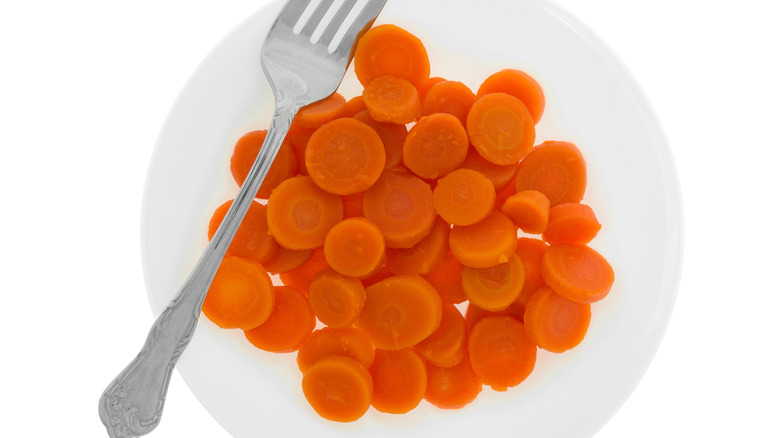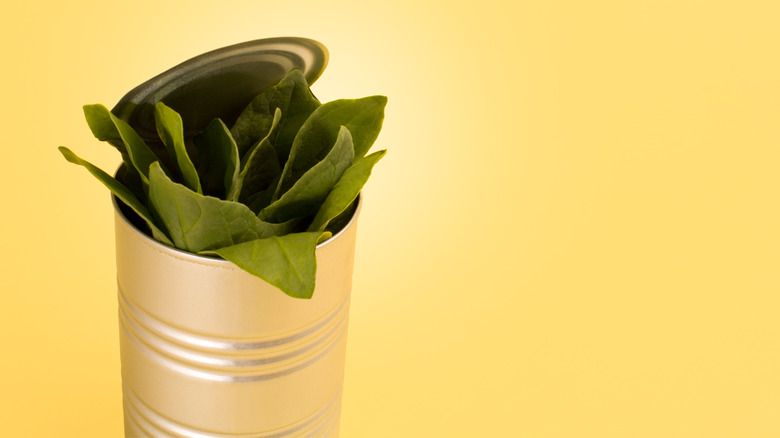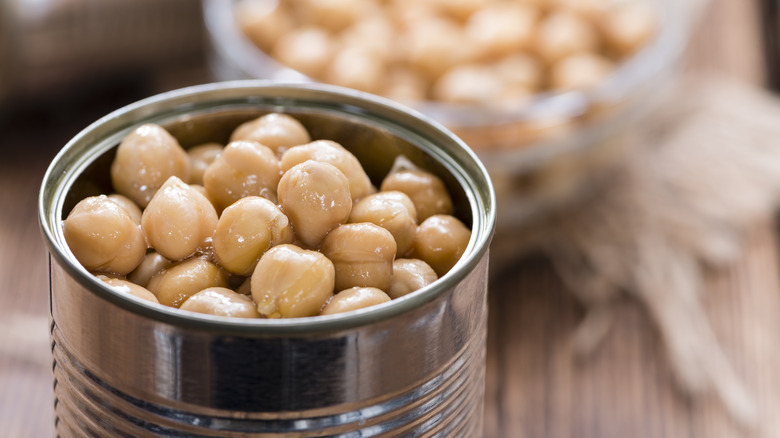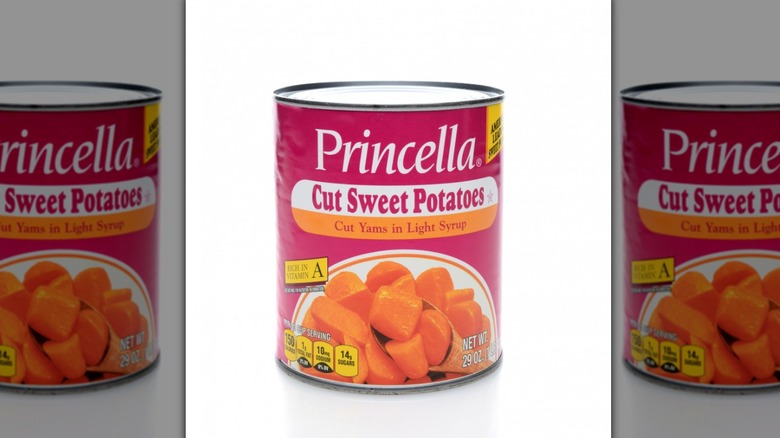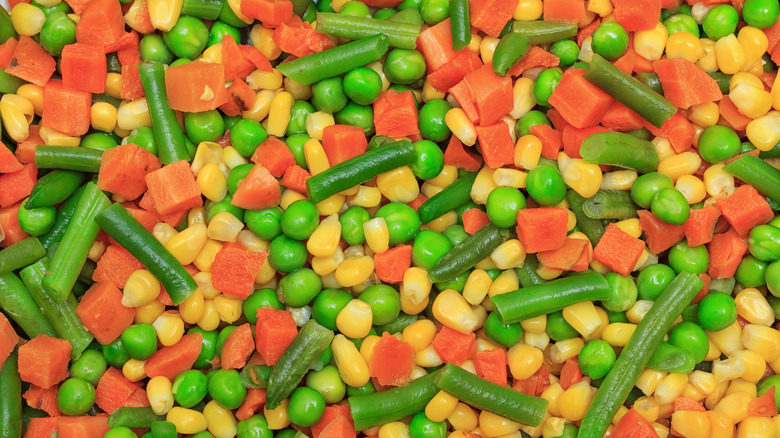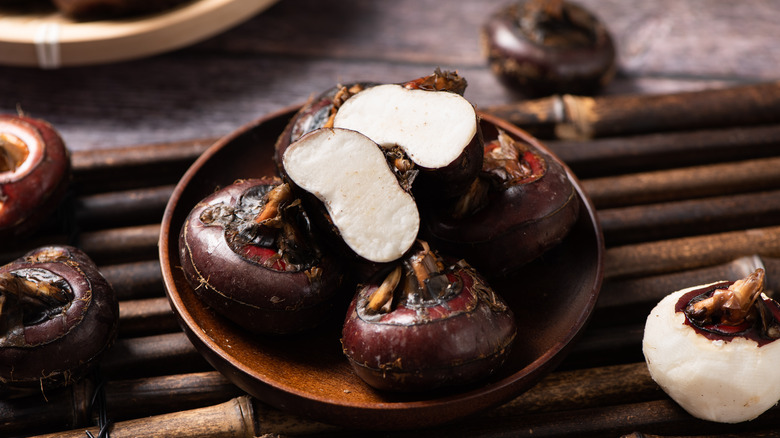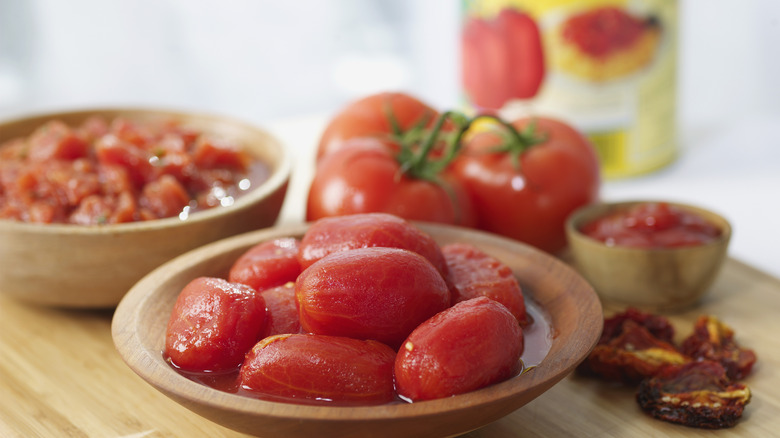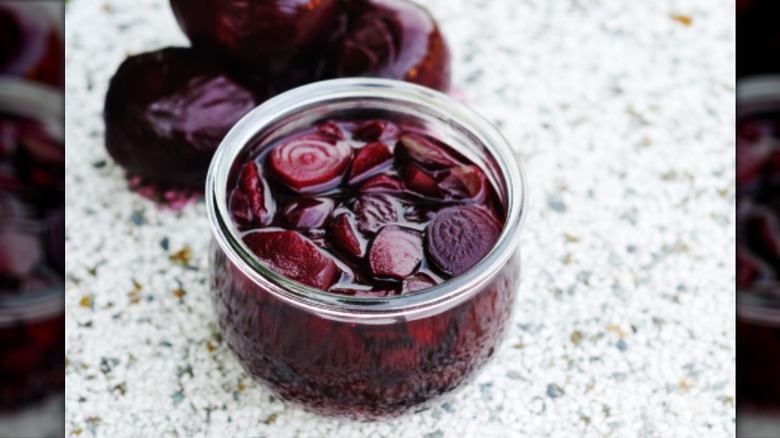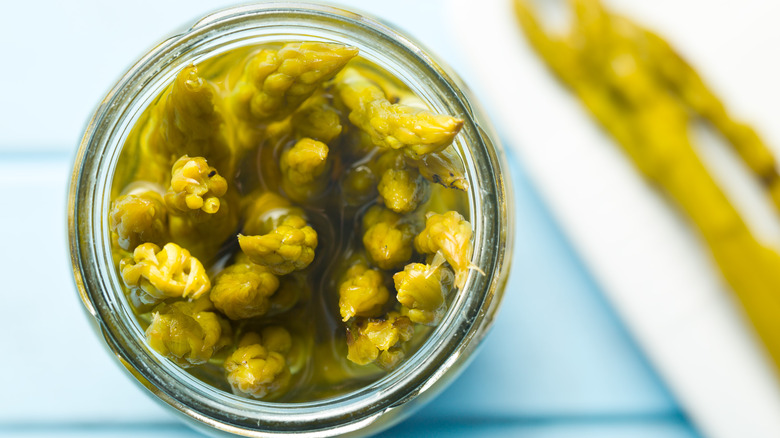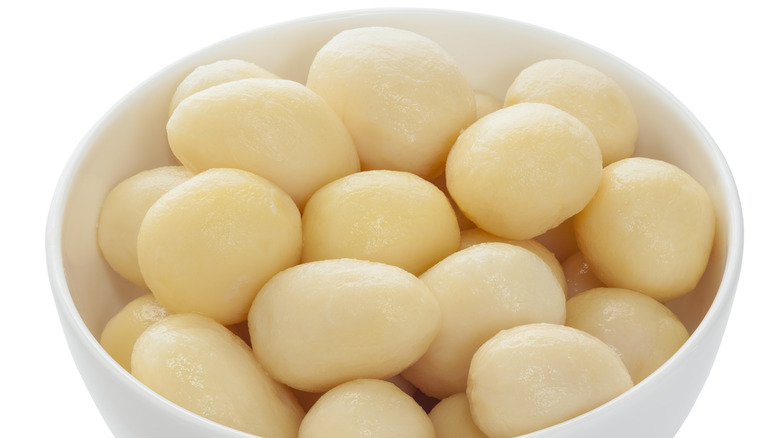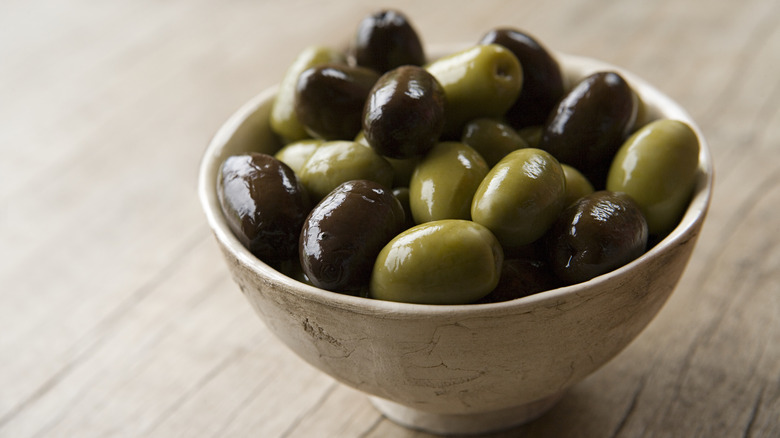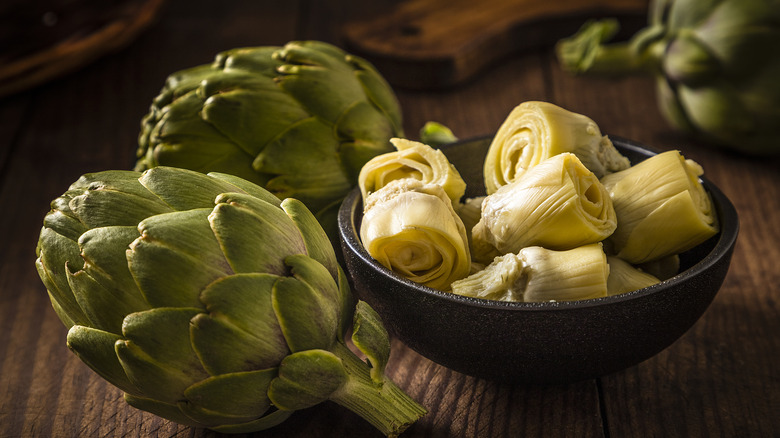16 Canned Vegetables You Should Consider Stocking In Your Pantry
In 1811, British merchant Peter Durand patented the process of preserving food in a tin can as a way to safely feed the British army. Canning food for preservation was nothing new for many in the United States, but home canning was a tricky process that could sometimes end in accidental food poisoning and even death. Industrial canned food was considered a safer process, but it wasn't until Gail Bordon's 1856 invention of condensed milk in a can that canned goods really took hold. Canned vegetables suddenly had a longer shelf life, even if some homemade ones ran the risk of uneven sanitation and a Russian roulette of bacteria.
These days, canned goods are a critical part of any well-stocked pantry. They make quick meals easy to whip up on busy weeknights, and can be much higher quality than their frozen counterparts. Many brands are now offering low-sodium and organic options, some with no added flavors — a good blank canvas for a home chef.
Canned goods can last years when stored properly. The United States Department of Agriculture (USDA) says that if no bulging, dents, or rust is visible, canned vegetables are safe to eat indefinitely.
When fresh food isn't available, and home canning is not an option, canned vegetables are an affordable alternative. But when pantry space is at a premium, which canned vegetables are most essential that you keep on hand?
Green Beans
Canned green beans get a bad rap that, let's be honest, they sometimes deserve. Due to processing times (and occasionally added ingredients), canned green beans often lose their cheery hue in favor of a dullish, muted green more reminiscent of buffet lines and school cafeterias than gourmet meals at home.
But make no mistake: Canned green beans can hold it down for dinner. You may be familiar with plain, cut green beans, but there are also French-style ones (long and thin) and Italian green beans (which are flat). These bring a different texture to the table, and a serving of canned green beans adds protein, iron, and fiber to a meal without adding many calories. They are also quite adaptable; eat them heated up and straight out of the can, or take a minute and add some flavors.
Try draining the green beans, then add beef stock, and simmer with onion powder, garlic powder, and butter until the stock is reduced by half. Use as a green addition in a tater tot casserole or add to minestrone to add fiber. Pan roast salmon with lemon compound butter, arranging green beans on the pan for the last five minutes to warm. Or, go with the old favorite: green bean casserole topped with fried onions.
Corn
An easy win and a no-brainer for stocking the pantry, canned corn is sweet and most closely mirrors the flavor of fresh corn on the cob. Skip the tasteless, frostbitten chunks of freezer corn. Looking for nutrition? You're in luck there: It's every bit as healthy as fresh corn on the cob, at about half the price.
Canned corn is a great choice for a starchy side dish, but also plays well in casseroles, soups, pasta, and even as a puréed base for a sauce. Because of its high sugar content, it offsets bitter flavors and evens out sour notes and various dishes. Corn's flavor profile is versatile enough for an elegant soufflé or a punchy street corn recipe. It loves everything from bold, spicy sauces to creamy, elegant bisques.
But it's not just for lunch and dinner. Canned corn can be used in desserts, too. Think sweet corn, ice cream, upside-down fruit cakes with puréed corn in the batter, and sweet corn pudding.
Peas
Canned peas suffer from the same identity crisis as their green bean counterparts, but once again, it all comes down to cooking. The industrial canning process cooks vegetables at high heat to ensure safety, and delicate peas sometimes suffer from it.
But canned peas deserve a place at the table. They have good amounts of vitamin A, vitamin C, potassium, and fiber. They are a starchy vegetable that works for various diets, and their flavor is adaptable and can be boosted easily in many different recipes. Elevate grilled meat by resting it on a pea purée. Add a can of drained peas to beef stew for another layer of sweetness and flavor.
A final note: Some people mistakenly toss their canned peas when they appear cloudy upon opening. Cloudiness in peas, both store-bought and home-canned, is a normal result of the cooking process, releasing starch from the vegetable. This starch causes cloudiness, but if the peas are in a can that is not damaged or rusted, they are safe to eat.
Carrots
One canned vegetable that should be a staple in any pantry is carrots, which lose very few nutrients when preserved. Sliced into coins or chunks, these bright orange beauties have plenty of vitamins, minerals, and protein. Canned vegetables are picked and packed at their freshest, and carrots keep their flavor and nutrition largely intact. Cooked carrots, like tomatoes, have more beta-carotene than raw ones. This gives carrots their bright hue but is also great for eye and skin health, cancer prevention, and memory support.
Because they are already fully cooked, adding too much heat to canned carrots can take them from just done to fully mushy. Instead of choosing long cooking processes, use canned carrots in recipes that merely need warming or finishing. Think glazed carrots or carrots in an air fryer. Ginger, brown sugar, and orange are great flavor combinations for carrot dishes.
But if you do cook them to the other side of mushy? Don't panic. Blend those mushy carrots, then add them to a carrot cake or soup.
Spinach
Popeye was strong to the finish, because he ate canned spinach: Just one-half cup of canned spinach delivers 70% of the recommended daily allowance of vitamin A and 100% of vitamin K. These two vitamins form bones and tissues and protect the body against infection. Canned spinach is also an affordable vegetable when fresh greens are not readily available.
Part of the beauty of slow-cooked or braised greens is the "pot liquor" (or pot likker) in which they are stewed. With canned spinach on hand, that pot liquor is built in; it just needs a few additions to access the full flavor of this hardy green side dish. Bacon is a great addition, or add some tomatoes, garlic, and onion. Creamed canned spinach can be made vegan with a cashew-based sauce, or add a splash of lemon juice or red wine vinegar to brighten the flavor.
For the best flavor and texture, be sure to drain and rinse spinach. Always remove the liquid when using canned spinach in a dip or egg dish, or it might cause watery eggs and muddy dips.
Beans
Canned beans are a staple pantry item in many cuisines. Many people don't think of beans as a vegetable, but botany has your back. Hardworking and protein- and fiber-packed, chickpeas, black beans, kidney beans, and cannellini beans are a subgroup of vegetables called legumes.
It's hard to overstate just how good for you beans are, particularly canned beans. Multiple studies have cited legumes for their ability to lower the risk of chronic disease. They are also good for the heart, reducing clinical obesity and the risk of some types of cancer.
Their protein content makes them great as a vegetarian main course, but canned beans are used across a variety of culinary applications. Try black bean soup, chickpea tacos, and chili to get started, then move into making hummus. Fresh tuna with white beans, olive oil, and garlic is a perfect summer lunch, or boost protein and fiber by tossing a handful of drained and rinsed beans into a favorite salad.
Pro tip: Save the liquid from those drained chickpeas. Use this aquafaba to make everything from vegan meringues to chocolate mousse, or as a substitute for egg whites in baked goods and vegan cocktails.
Sweet potatoes
Like their carrot cousins, canned sweet potatoes are another high-octane veggie when it comes to beta-carotene. They also have tons of vitamin A and fiber, plus their natural sweetness is great for satisfying a dessert craving without excess sugar.
You'll not get any crunch from a canned sweet potato, so work with the texture you've got. Sweet potato pie is an easy go-to, as is a velvety soup or curry. African peanut stew is a vibrant, delicious dish loaded with all the nutrition you need on a bitterly cold winter's day. This dish pulls from regions across Africa and combines sweet potatoes, bell peppers, tomatoes, ginger, red pepper flakes, and peanut butter for a soul-satisfying meal. You can play on mafé, a Senegalese stew, by swapping sweet potatoes for some or all of the traditionally-used carrots.
Take care with these naturally sweet root veggies; they are packed in syrup and need to be rinsed before use. The excessive sugar in some brands won't work well in more savory dishes.
Mixed vegetables
With a can of mixed vegetables, you have a reliable base for many family favorites. The veggies vary but typically include carrots, peas, corn, and lima or green beans. This is a rounded balance of flavor and nutrition, and can be added to bump up the nutrition in many soups, but there are other ways to use them.
Adding canned veggies alongside fresh is a great way to boost flavor on a budget. Try cowboy caviar — a chunky dip with canned veggies, avocado, and fresh onion — or stretch the remaining fresh vegetables in the fridge to create a big salad.
Another easy way to use mixed canned vegetables is in a chicken or veggie pot pie. Make a roux with flour and butter, then add stock to create a sauce seasoned with salt, pepper, and plenty of thyme. Place frozen mixed veggies in a frozen pie crust, then add sauce and diced cooked chicken. Top with whipped potatoes, then bake to bubbling perfection.
Water chestnuts
Water chestnuts may be grown in water, but they are definitely not nuts. Typically found in Asian take-out, there is so much more to this aquatic tuber that is grown in shallow lakes and ponds.
One serving of water chestnuts is packed with fiber, potassium, and B6. They also have 2 grams of protein and are a filling, low-calorie food. The antioxidant compounds in water chestnuts lower the risk of heart disease, diabetes, and some cancers. They can lower the risk of heart disease and help a person lose weight due to their high water content, fiber, and protein that keeps you fuller.
Water chestnuts can be eaten fresh, boiled, baked, or fried. Their texture remains crisp no matter the baking method, which makes them great for adding texture to soups and stir-fries. When eaten raw, water chestnuts crunch like an apple and have a slightly sweet, almost nutty taste. Because of their high starch content, water chestnuts can also be used as a thickener for sauces and stews. If eating gluten-free, experiment with dried water chestnut flour as a baking alternative.
Tomatoes (diced or whole)
Nearly every pantry has a can or two of tomatoes lurking in it somewhere. As with carrots and sweet potatoes, cooked and canned tomatoes have higher amounts of a beneficial compound than in their fresh state: lycopene. Lycopene is great for heart health and can prevent certain types of cancer.
But the main benefit of tomatoes? They taste delicious in their canned state. When buying, look for brands that list the type of tomato on the can. These are generally of higher quality and will yield the best flavor. Canned tomatoes come in many forms, including whole, diced, and petite diced. Some companies add ingredients such as jalapenos or green peppers, while others fire-roast their tomatoes to bring out even more flavor.
Regardless of which you choose, the culinary possibilities are endless. Use fire-roasted tomatoes in a spicy soup. Braise beef and shred for tacos all week. Crack an egg or two into a spicy tomato sauce for a quick weeknight shakshuka. Use the remnants of an open can of tomatoes to make Tex-Mex rice.
Beets
Those who don't like beets might have a hard time being convinced they should be stocked in the pantry. But consider these two words: chocolate cake. When blended smooth, canned beets make one moist and deeply flavored while adding protein. So, while beets don't quite turn chocolate cake into health food, they do bump up the nutrition.
But that' not all canned beats can do. These vibrantly purple root vegetables add sweetness and color to various dishes from across the globe. Consider chopping canned beets and adding them to a simple salad or combining with chickpeas for a bright pink Valentine's Day hummus. Canned beets can also be diced and added to a colorful risotto finished with salty feta cheese or rough chopped for a sweet, tangy side dish called Harvard beets.
One thing to remember: Canned beets will stain clothes and cutting boards. Prepare them carefully.
Asparagus
Few things are more delicious than tender spring asparagus, cooked with nothing but a bit of butter, salt, and pepper. But this springtime experience is fleeting, and fresh asparagus from the grocery store is often tough, thick, and woody.
If you enjoy the flavor of asparagus without the prep time, canned asparagus is a good option. Fully cooked and packed quickly, canned asparagus has tons of fiber, vitamin C, and folate, making it a great vegetable for pregnant people.
Cooking canned asparagus on the stove may result in mush. For the best flavor and texture, roast canned asparagus as you would fresh, pop it in the air fryer, or drain and rinse before chopping and adding to omelets or salads. The air fryer is the best option for a crispy texture; it dries the outside of the asparagus and crisps it up.
One of the best ways to harness the delicious flavor of asparagus while avoiding an unpleasant texture is cream of asparagus soup. Because the soup is blended, there's no need to worry about excessive cooking time. Better still, it uses another canned pantry staple as a thickener: potatoes.
Potatoes
One of the best vegetables on earth, potatoes are endlessly versatile, low in calories, high in fiber, and low in fat. They carry everything well, from ketchup to bacon and cheddar cheese. They keep forever in the pantry, and they are an affordable food.
Want to reap all of the benefits of potatoes without peeling and long cooking times? Canned potatoes are the way to go. While they are technically ready to eat straight from the can, drain and rinse the potatoes before you get to work.
Use them as a thickener (as in the cream of asparagus soup), but go way further than that. Grab a mandoline and slice thinly for potatoes Anna or a simple gratin. Boil until soft, then make a mash to top mixed veggie pot pie. Slice into steak fries, season with onion powder, garlic powder, salt, and pepper, and you're minutes away from healthier air fryer spuds.
Olives
Technically, olives are a fruit, but their savory nature means they are generally classified as a vegetable. Olives are the perfect little snack before dinner — they are salty and prepare the body for the main course without filling you up.
But they are good for more than just snacking. Olives feature prominently in Mediterranean dishes, such as baked fish with olives and fresh pasta with olives, capers, and artichoke hearts. The type of olive you use influences the dish you'll make. Some are larger and good for stuffing with pimentos, garlic, or cheese, while others are smaller and can be added whole or chopped into dishes.
Add olives to pizza, or create a delicious olive tapenade. Another great Mediterranean dish that is light but filling is Mediterranean olive salad. This refreshing summer staple uses a grain (such as couscous or quinoa), adding chopped olives and cucumbers and dressing with pomegranate molasses, lemon, olive oil, and fresh mint.
Artichoke hearts
A perfect example of a fresh vegetable made better by canning, the center of an artichoke is a thorny place that requires a lot of effort to get to — but not when they come in a can.
In cans, artichoke hearts are available plain or in a marinade. Marinated artichoke hearts can be part of an antipasti or appetizer, but plain artichoke hearts are more versatile. Breaded and fried in an air fryer, artichoke hearts become a zippy finger food. Chop marinated artichoke hearts into a pasta sauce, or blitz them in a food processor to make dip. Add breadcrumbs, cheese, and lemon for a zippy gratin, or create a simple salad.
No matter the preparation, artichoke hearts are a simple canned vegetable that can elevate everyday dishes. They add a bright burst of flavor and a toothsome texture that brings simple dishes to life — with less work.
Hearts of palm
Vegans rejoice. A crabcake's delicious taste and texture (minus the crustacean) is within reach, courtesy of hearts of palm. This is the tender, delicious center of a palm tree, with a delicate flavor similar to artichoke hearts and a texture that, when chopped, can be used to simulate crab meat.
But this ingredient is not without controversy. To get to the heart, a palm tree must be completely chopped down and stripped bare of all outer layers. Once harvested only from mature trees, hearts of palm are so in demand that unscrupulous farmers have begun to harvest young trees, too.
Fortunately, some species of palm trees have multiple stalks, and harvesting one does not kill the tree. It's critical to make sure your hearts of palm were sustainably harvested. Once you verify its provenance, bust out the Old Bay.
